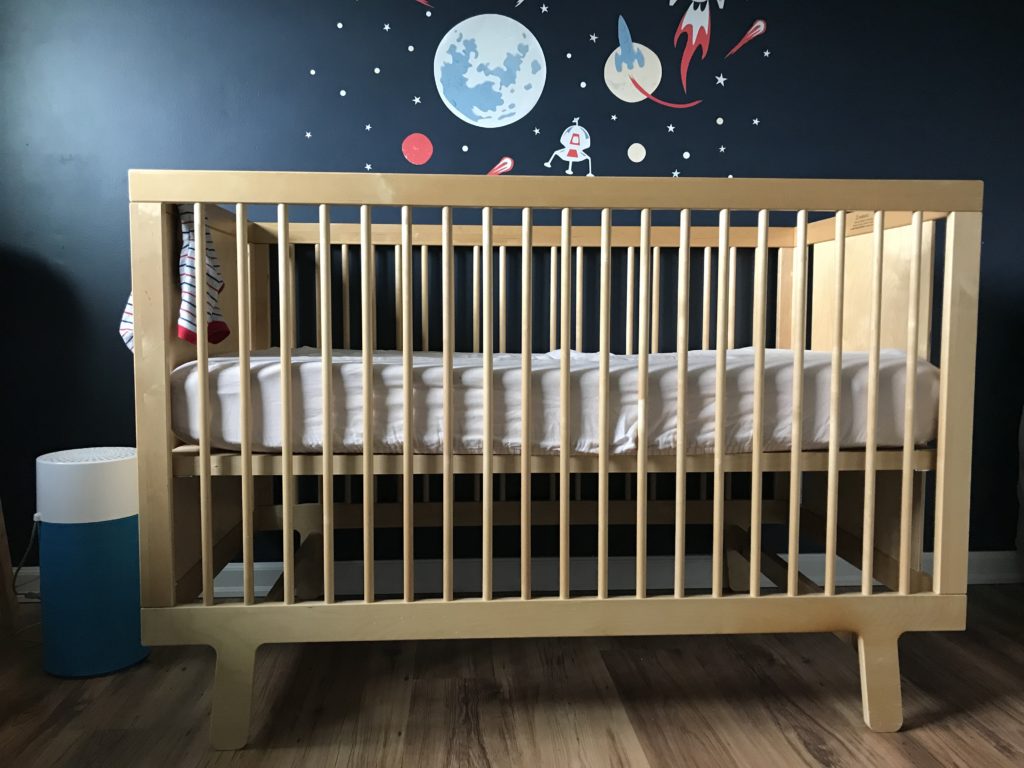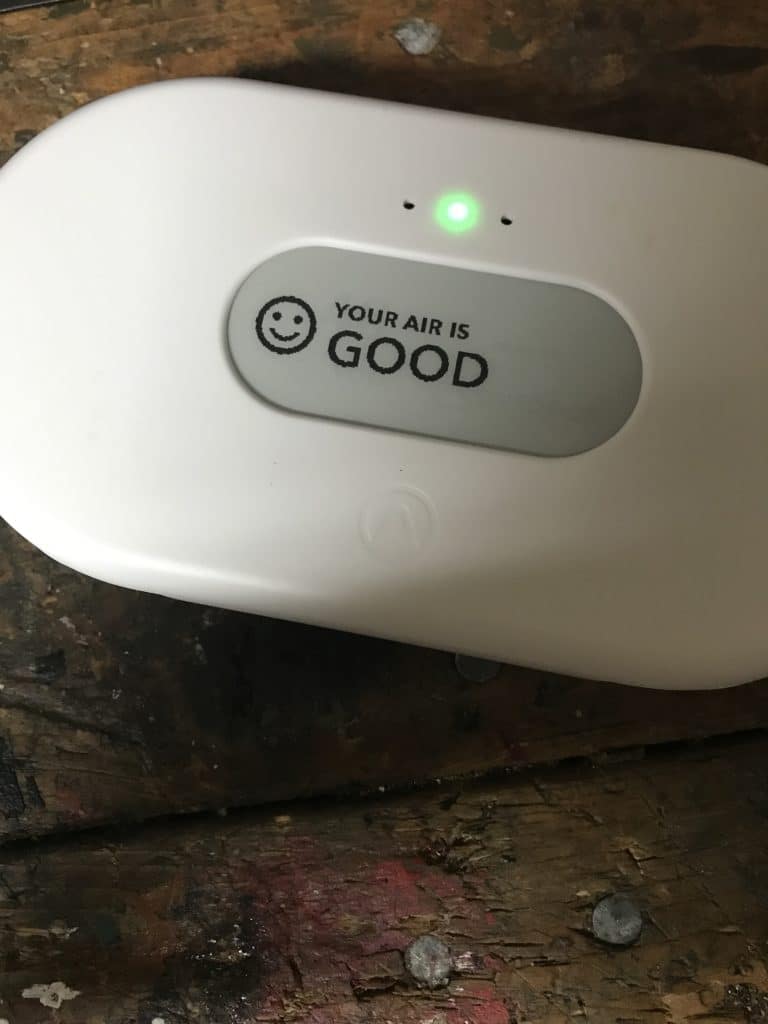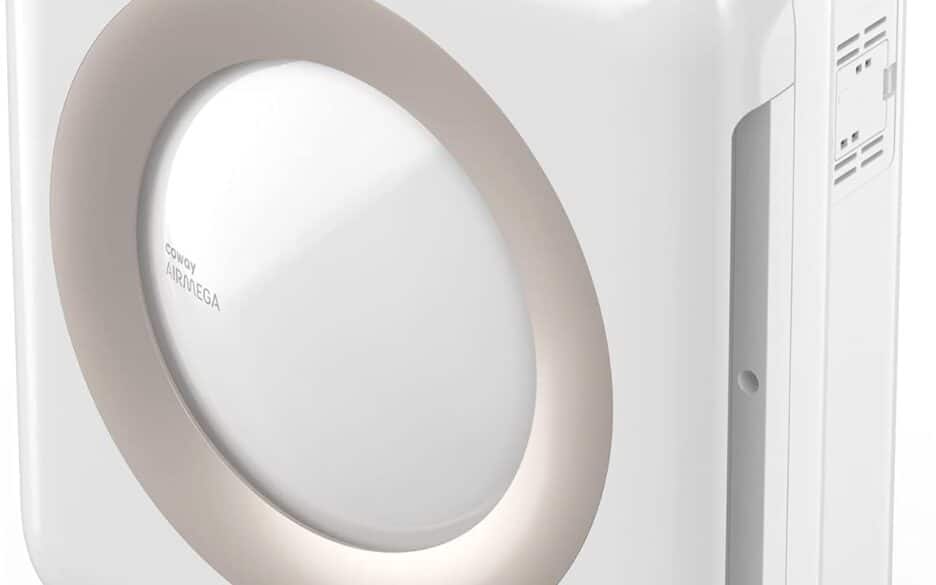What is the best air filter to keep your new baby breathing clean air? As a new Mom, this is an issue I have drilled down on with extra emphasis. The good news is there is a body of scientific research we can turn to when selecting an air purification system for our kids.

An air filter can do triple duty in the nursery, acting as a:
- White noise machine
- Nightlight
- Air filter!
An air filter can ensure clean and safe air in your baby’s nursery. Not all air filters work the same, though, and the type of filter you need depends on the kind of air pollution you’re dealing with.
There are plenty of excellent reasons to consider getting a home air purifier elsewhere in the home. In the nursery, though, an air filter can vastly improve air quality to reduce allergy symptoms and support little lungs just developing.
What to look for
For optimal air filtration in the nursery or any room in your home, consider:
- Good airflow and ventilation (and a suitably sized filter)
- An ability to filter out a range of particles, small to large, in different ways
- Easy maintenance and upkeep (and low-cost filter replacements)
- An ozone-free filter, as certified by the International Association of Air Cleaner Manufacturers (IAACM)
It’s also good to look for an air purifier with an AHAM Verifide seal and a CADR (clean air delivery rate), which tells you the volume of clean air a model produces at its top setting.
In a test of six commercially available brands, Hacker and Sparrow looked at three electrostatic precipitators and three HEPA filters. Of these, one offered no benefit at all (this was confirmed in another study), so avoid the heavily marketed Ionic Breeze Quadra.
Of the six units tested, the HEPA filters worked best, while the electrostatic devices were less efficient.
A note on wildfire smoke
A CADR of 150 for tobacco (or wildfire smoke) filters air in such a way as to be the equivalent of adding 150 cubic feet of clean air every minute. (Hopefully, there’s no tobacco smoke near the nursery though!)
Unfortunately, smoke from wildfires travels for hundreds and thousands of miles, so air filtration in nurseries is likely to become a bigger issue as climate change increases the frequency of wildfires across the western United States.
For more on the best air purifiers for wildfire smoke, see Lydia’s piece The 7 Best Air Purifiers to Neutralize Smoke.
Factors that impact air quality in the nursery
Many things can have a dramatic effect on indoor air quality, including:
- Wildfire/climate fires
- Living near a freeway or busy intersection
- Living near a coal power plant or manufacturing facility
- Living near farmland sprayed with pesticides and herbicides
- Bringing new furniture and furnishings into the home that off-gas chemicals
- Cooking with Teflon-coated cookware and some other non-stick cookware
In addition to choosing household products like rugs, mattresses, and paint that don’t off-gas pollutants, air filters can significantly improve indoor air quality. A good air filter can also significantly reduce airborne allergens as well as pollutants.
Many filters don’t, however, remove toxic exhaust gases such as benzene and 1,3-butadiene, or other harmful ingredients in traffic pollution or common indoor air pollutants such as formaldehyde. For that, you’ll need a high-efficiency filter and you’ll need to replace filters regularly, usually every few months.
Our top picks for a nursery air-purifier
With all the necessary research bases covered so you can be an educated consumer, here are our top picks for nursery air purifiers. Curious about how we rate products? Click here to view our methodology, which at its core, is about voting with our dollars to fight climate change.
- Ozone-free
- Top of the line technology
- Portable
- Dual voltage – can be used internationally
- Only filters small 32 sq. feet
Designed to clean the air in a smaller space, this air filter is super lightweight, weighing just 6 lbs. It’s a great choice for taking with you when traveling and contains 32 sq. ft. of HyperHEPA™ filtration media, providing particle removal down to 0.003 microns (99%). The PureJet diffuser allows for optimal positioning, such as near your baby’s crib (just remember to keep cords out of reach).
- Medical grade air purifier
- Advanced clean air delivery rate
- Great for larger nurseries
- Replacement filters are expensive and wasteful
- Machine is large and cumbersome to move
For nurseries up to 285 square feet and with significant air pollution, allergens, or mold, the IQAir Health Pro Plus is a must.
This beast sure ain’t pretty but it removes 99% of larger airborne particles including:
- Pollen
- Dust
- Pet dander
- Mold spores
- Other pollutants.
It captures particles as small as 0.003 microns and can eliminate a variety of volatile organic compounds (VOCs), odors, and other gaseous chemicals. That makes it the perfect fit for the nursery if you’re concerned about VOCs off-gassing from paint, furniture, or other items.
IQ Air markets this purifier as the “number one air purifier to combat smoke” because of the ability to capture particles as small as 0.003 microns. We also like it for its ability to clear viruses, though we do wish the filters were less wasteful and less expensive.
- Highly efficient (AHAM rated at 161 sq. ft., 120 cubic ft. per min CADR)
- Clears allergens, wildfire smoke, smog, VOCs, and viruses
- Smart 3-stage filter design
- Quiet on first two settings
- Doubles as white noise machine on top setting
- Also a nightlight
- Energy efficient
- Filters may not need replacing more than once a year (unless you have furry pets)
- Can’t turn off the light! (We put decorator’s tape over it)
- Filter replacements are pricey
- No child-lock (it will be tempting for toddlers)
I have been using this air purifier for four years, since the summer of 2021, which saw a heat dome and wildfire smoke in the Pacific Northwest, where I live. At the time, I was nine months’ pregnant and very concerned about the dangerous impact of particulate matter in late pregnancy.
Fast forward nearly four years and we now have two of these 411s, with one still in use in our kid’s room. In all that time, I have changed the inside filters four times. This is super easy to do. My toddler helps me with this task these days and also loves to turn the filter on and off. This is one of the downsides to the unit, which has a simple one touch button that leads to lights and fun whooshing of air… and no child-lock.
If you can, put this unit out of reach until your kid is old enough to grasp that they shouldn’t grasp it.



Other things I love about this purifier include the ability to wash the pre-filter. We have a very hairy dog, so I wash the pre-filter every month and vacuum it weekly. You can also get replacement pre-filters in different colors to suit your nursery’s aesthetic.
Another big plus for this unit is its relative quietness. Per BlueAir, the 411 produces 17-46 decibels. Per my testing from a meter away, this is more like 15-38 dB. That’s well within safety limits for nursery noise, while still offering a good amount of white noise at the top setting.
One other downside to the 411 is that you can’t turn off the lights. We’ve positioned ours strategically to avoid the glare while trying to sleep, but we also found it effective to use painter’s tape to cover the three strips of light.
- Impressive performance with 3-stage filtration including HEPA
- Quiet – Just 53.8 dB at its loudest! (24.4 dB on lowest setting)
- Can turn off lights
- Compact and unintrusive
- Very affordable (including filter replacements)
- Looks good! (It’s also available in black with a grill design)
- Timer settings, auto setting that adjusts to air quality, and Eco-mode
- Best for rooms up to 361 sq. ft
- Reduces up to 99. 97% of particles 0. 3 microns in the air
- Can tackle pollen, pollutants, allergens, VOCs and odors
- Has in-built sensor for air quality (with handy LED color coded lights)
- Filter lifetime indicator
- Washable pre-filter with indicator
- Very low energy consumption (77 W)
- Limited manufacturer’s warranty (1-year for internal/functional parts, 3-years for motor and electronic parts)
- Has an optional ionizer
- No child-lock (kids can accidentally turn on the ionizer, which isn’t great)
If you’re mainly concerned about wildfire smoke, Coway’s impressive air filter is a good choice. That said, you’ll want to keep this one out of reach of curious hands as there’s no child lock and there is an ionizer setting. Personally, I would never turn on the ionizer, even though it’s technically rated as safe and won’t produce measurable ozone that could be hazardous for young lungs.
On the plus side, this filter is exceptionally powerful while still being very quiet. And, unlike the BlueAir 411, you can turn off the lights.
This unit is also more economical, with a lower upfront price and cheaper, less frequent filter replacements (view on Amazon). It also has a higher CADR for many pollutants:
- Dust – 246
- Pollen 240
- Smoke 233.
The Coway even boasts a built-in sensor that will turn off the fan and set the filter to Eco-mode if there’s no detectable pollution for 30 minutes. That said, you may want to avoid using the auto-mode or eco-mode if you’re relying on the Coway as a nightlight and for white noise.
FAQs
Clean Air Delivery Rate (CADR) is a measure of the volume of air a unit delivers at its top setting. A higher CADR means greater efficiency and speed at filtering air.
CADRs can be misleading though. Be sure to check the CADR for the specific types of air pollutant that concern you. For instance, if your main concern in the nursery is pollen, a model with a high CADR for formaldehyde doesn’t necessarily help and may be more costly than one that’s better for pollen but less effective at filtering formaldehyde fumes.
In general, a CADR of 240 or more is excellent, while a filter with a CADR below 60 isn’t going to be all that helpful.
If you have central air or central heating, you can install a high-efficiency air filter system. Choose one rated 13 or higher on the 16-point industry MERV scale (Minimum Efficiency Reporting Value). This scale measures how effectively a filter blocks tiny pollution particles.
In some places, such as California, local regulations require MERV 13 air filtration in all newly built residential buildings. So, if you have the option, choose a newer building with good air filtration rather than an older one that is less likely to be air-tight and more likely to harbor mold and other respiratory hazards.
In homes without central air, a stand-alone filter is an effective option for purifying the air in a single room.
In one study that took place over three to four seasons, researchers set up free-standing air filters and window air conditioners in the bedrooms of over a hundred kids with asthma and then monitored indoor air quality. They found that air filters reduced particulate matter levels by 50%. Similar results were seen in another study, where air filters reduced particulate matter by an average of 69-80%.
Airborne droplets are responsible for diseases like tuberculosis, influenza, CoVID, some types of herpes zoster, and childhood infections such as chickenpox and measles. HEPA air filters can filter out many airborne infectious pathogens, including some viruses, bacteria, and fungi (though air filters should not be used in lieu of vaccinations against preventable diseases).
By using a HEPA filter year-round, you’re doing your lungs and general health a favor, meaning you’re in better shape to tackle any bugs that do come your way.





